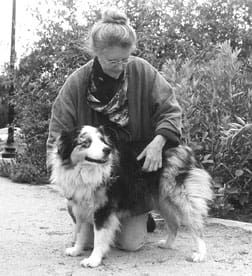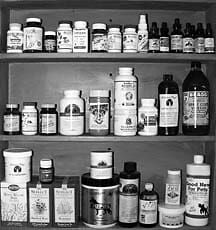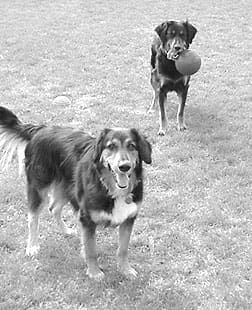Some dogs have a rough start in life. Consider BP, the 50-pound black-and-tan Shepherd-mix owned by Lucia Colbert of Cordova, Tennessee. BP was dumped in a neighborhood and left to fend for herself until rescued by Colbert in 1988. Colbert took the thin and sickly dog to the vet: BP had a host of internal parasites, including heartworms; part of her tongue was missing; and she had a chest full of buckshot (discovered later on a chest x-ray). “I knew she’s hadn’t had a piece of cake for puppyhood,” says Colbert.
Once adopted, BP thrived. She enjoyed a good life with Colbert, a professional tennis player and triathlete. BP jogged daily with Colbert and sat by the tennis court while she taught.
BP’s new life wasn’t without challenges, however. All her adult life, the floppy-eared mix was plagued with severe allergies. BP suffered hot spots, and chewed and licked herself constantly. Life was a parade of visits to allopathic vet clinics ( including specialists); her medical file was three inches thick. “She was constantly on antibiotics, and then they’d give her cortisone shots,” says Colbert.

Colbert fed BP whatever her veterinarian recommended, usually a high-priced food sold at the clinic. “I thought, I’m buying the best thing here. This has got to be it,” she says.
As Colbert saw it at the time, BP’s only other health problem was some mild arthritis. However, the condition responded fairly well to Rimadyl, an anti-inflammatory drug prescribed by the veterinarian.
Crisis leads to change
Allergies and arthritis aside, Colbert thought her canine companion was fairly healthy. But in 1997, Colbert noticed her jogging companion wasn’t running as well and was coughing at night. Subsequent veterinary examinations saw BP diagnosed with congestive heart failure, with a grim prognosis for the future.
“Well, I didn’t like that,” says Colbert, who began researching congestive heart failure. She also consulted with a friend who was a holistic nutritionist. Colbert’s efforts prompted her to change BP’s diet immediately to Flint River, a commercially prepared food that is free of artificial preservatives, colors, or flavors, and contains better-quality ingredients. She added a fresh blend of oils (flax, sesame, evening primrose) to give BP the right balance of Omega-3 and Omega-6 fatty acids. “The allergies went away within a month or two,” says Colbert, “never to return.”
Colbert also stopped giving BP Rimadyl, replacing it with a glucosamine and chondroitin supplement. With the help of these far more benign supplements, she still displayed a small amount of stiffness, but did not get sore and achy.
The new diet and supplements improved BP’s heart condition, to the point where she could resume her runs with Colbert. Eventually, she was back up to her old mileage, easily jogging with her athletic friend for as much as 10 miles at a clip.
The improvements were so dramatic, that Colbert herself began taking some supplements for her own health, with great effect. “I take a few supplements for my health and endurance, too,” she laughs. “I’ve gotten fascinated with all these things.”
Not yet the end
In summer 1999, BP began experiencing another downhill slide. With the onset of hot Tennessee summer weather, even with a vastly reduced exercise schedule, the senior Shepherd began having a difficult time breathing. Colbert’s veterinarian told her that this was to be expected of a 15-year-old dog. “She’s just getting old,” the vet told Colbert.
But Colbert decided to do some more research. Her efforts to improve the dog’s health with a better diet had strengthened her belief that there was probably more she could be doing to help her beloved dog.
Colbert bought a copy of a book written by holistic veterinarian Martin Goldstein, The Nature of Animal Healing: The Path to Your Pet’s Health, Happiness and Longevity (Knopf 1999). Dr. Goldstein, a graduate of the Cornell University College of Veterinary Medicine and owner of a veterinary clinic in South Salem, New York, offers an alternative approach to healing in his book. The author’s premise is that the best way to treat an sick pet is to help the animal heal itself.
Colbert was thrilled with the veterinarian’s approach, and took the book’s message to heart. She also contacted Dr. Goldstein’s brother, Robert Goldstein, who is also a holistic veterinarian, for help with BP.
Since Dr. Bob and Susan Goldstein’s Holistic Veterinary Center is located in Westport, Connecticut – quite a distance from Cordova, Tennessee – an office visit was out of the question. But the Goldsteins, like many holistic veterinarians, offer consultations by telephone, e-mail, and/or fax, usually in conjunction with the client’s hometown veterinarian.
One of the most frequently employed services of Dr. Robert Goldstein’s clinic is his use of what he calls a “bio-nutritional analysis” of the patient’s blood tests. Generally, the client will have his or her own veterinarian draw blood and submit the samples for specific tests according to Dr. Goldstein’s directions. Goldstein or one of his associates at his clinic then analyzes the results and makes recommendations for changing the dog’s medication or supplements accordingly.
Colbert’s local veterinarian supported the plan, and drew blood from BP so the analysis could take place. After the results of the tests reached Dr. Goldstein’s clinic, Colbert received a call from Dr. Brian Wessels, an associate at the Westport clinic. One thing the tests revealed was a problem with BP’s liver. “Her liver enzymes were out the roof,” says Colbert. A normal count is 200-300, says Colbert. BP’s were 1200.
Dr. Wessels made several recommendations for BP. The “to do” list included adding some 19 nutritional supplements, and some homeopathic and herbal remedies to bolster BP’s various weaknesses (heart, arthritis, liver). He also suggested adding raw and cooked vegetables, garlic, and brewer’s yeast to her natural dog food. Two further steps were also recommended for strengthening BP’s immune system: discontinuing administration of BR’s heartworm preventive and any vaccinations.
“I had been using a Band-Aid approach to using herbs and things to help BP, to some extent, it worked,” says Colbert. “But with the analysis, they were able to zero in on what she needed. They would say, ‘OK, the garlic is good, this one is good, but hold off on that one . . .’ It helped me target the best supplements.”
However, adding 19 different things to BP’s food, “took a little getting used to,” admits Colbert. “At first, I used to mix all the tablets and powders into a half a cup of plain, non-fat yogurt, and she’d eat most of them, but I’d find a few things around the house that she had spit out. The I bought one of those little baby Cuisinarts, and mix everything in there – the supplements, the garlic, carrots, broccoli, and what I call the ‘enticer,’ a spoonful of tuna, salmon, egg, or chicken – and then mix the whole concoction into her kibble. She’s a chowhound, so she cleans all this up.”
Colbert was more reluctant to implement Dr. Wessels’ recommendation of stopping the heartworm preventive because of her past bout with the condition. However, garlic and brewer’s yeast is believed to help repel mosquitoes from some animals so Colbert followed doctor’s orders.
BP’s health improved. “Within two weeks I could tell a huge difference,” says Colbert. “Her whole body language changed. We re-tested her blood again in about two months and the liver scores were down to 600; the other numbers were coming into line and she was much, much better.” Colbert will continue having BP’s blood tested every six months to monitor her health and enable her to change anything in the protocol as necessary.
Maintaining the program
Colbert is extremely happy with BP’s new lease on life. “I think the holistic treatments added years to her life. I really do. Because most people look at me like I’m nuts when I say she’s 16. I don’t know how long she’s going to live, but I know she’s way healthier than she was.”
Colbert will also admit that it takes a lot of commitment to follow through on a program that is this complex. It’s also very costly. “The bloodwork and the evaluation is not that bad, but the supplements themselves are very costly,” says Colbert. “I appreciate everything they have done for us, and I will continue to consult them regularly, but I’m not rich! I’ve made it more affordable by finding a lot of the supplements (14 of the 19) on my own; the rest, I buy from the Goldsteins’ clinic.”
Colbert says the Goldsteins accept this readily. “They say it’s OK if you get these things on your own, but there are a couple I can’t find anywhere else!” she laughs. “But those ones, fortunately, are not the most expensive ones.”
Colbert wishes she had learned about a holistic approach sooner; but hindsight is 20-20. “For years I thought I was such a caring owner, which I am,” she says. “But I was unaware of the problems with putting her through all that cortisone, all those antibiotics, all that crummy food. Had I known that years ago, she wouldn’t have had to go through all that. There’s so many people who think they’re doing the right thing by doing that. But they’re just not doing their pets any favors by using the ‘quick fix’ medications. They don’t understand it takes the food, supplements, and consideration of the dog’s medication, and exposure to toxins. . . it takes time.”
Colbert says she realizes that giving BP Rimadyl in the earliest days of her arthritis didn’t do the dog any favors. “I probably overran her because of the Rimadyl,” she says regretfully. “I didn’t realize it at the time, but it masks the pain; that’s what enabled her to do more than she should have. I’d look at her and she’d look OK, she didn’t seem to be hurting, and I’d take her running when she probably shouldn’t have gone.” Today, Colbert uses the medication in a very low dose (half a tablet three times a week or so) to help the Shepherd stay mobile, but is careful that the dog doesn’t overdo it. Though greatly improved, BP is a senior dog and experiences some limitations that go along with that stage of life. “She can’t run anymore,” says Colbert, “but can do a great one mile walk.” Today, BP is happy to sit court-side while Colbert teaches; that’s her job now.
Colbert isn’t sure how much longer BP will live, but all indications are she has a ways to go still. Even Colbert’s conventional veterinarian is impressed with the elderly dog’s condition. Colbert reports, “Recently I was at the vet here in town and he made a comment that really made me feel good. Keep in mind this is the guy that three years ago told my husband to get ready because BP didn’t have long to go . . .
“In our most recent visit he examined BP and looked at me and said, ‘BP is going to outlive all of us. She is doing just fine!” He also said, ‘You know, there is something to all this stuff you are doing.’ ”
As if Colbert didn’t know!
-By Virginia Parker Guidry
Virginia Parker Guidry is a freelance writer from San Diego, CA.















